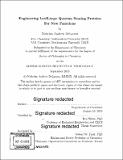Engineering LuxR-type quorum sensing proteins for new functions
Author(s)
DeLateur, Nicholas Andrew.
Download1142098829-MIT.pdf (12.15Mb)
Other Contributors
Massachusetts Institute of Technology. Department of Chemistry.
Advisor
Ron Weiss.
Terms of use
Metadata
Show full item recordAbstract
Bacteria communicate information in a process known as quorum sensing, actuating downstream gene expression based on cell-cell signalling. Cell-cell signalling allows for complex and multi-cellular behavior otherwise impossible with unicellular logic. However, building complex cell-cell signalling genetic circuits is currently challenged by a lack of tools for the fine-tuning and control of quorum sensing systems. Although derived from distinct biochemical entities, the diffusion rate and expression profile of a given LuxR-family module are not modular. Here, we develop chimeric proteins that can accept the small molecule cognate belonging to the las operon from Pseudomonas aeruginosa while activating the cognate promoter of other quorum sensing systems. The ability to swap in a modular fashion the ligand-binding domain and DNA-binding domain of transcription factors allows precise control of diffusion rates and expression profiles independently. Methods to control quorum sensing by transcriptional repression can be slow because they rely on dilution and degradation, require promoter engineering, or lack specificity against only a single signalling pathway. Here, we develop proteins to knock down expression from LuxR-type quorum sensing transcription factors utilizing molecular sequestration for fast, tunable, and specific control. Natural sequesters and engineered truncation proteins are successfully applied against 5 of the most prevalent LuxR-type transcription factors (LasR, LuxR, RhlR, RpaR, and TraR) as well as the chimeric transcription factors developed in this work. Chimeric LuxR-type quorum sensing proteins and proteins for the sequestration of LuxR-type quorum sensing proteins provide powerful new parts to facilitate building sophisticated gene circuitry.
Description
Thesis: Ph. D., Massachusetts Institute of Technology, Department of Chemistry, 2019 Cataloged from PDF version of thesis. Includes bibliographical references (pages 99-115).
Date issued
2019Department
Massachusetts Institute of Technology. Department of ChemistryPublisher
Massachusetts Institute of Technology
Keywords
Chemistry.